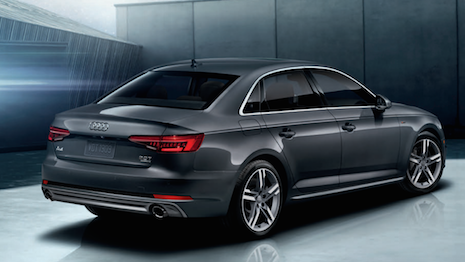German automaker Audi is transforming the market with the first offering of a futuristic technology.
Audi has announced that select 2017 models built in June or later are equipped to vehicle-to-infrastructure communication technology. The newfound capabilities will create a more relaxing environment for drivers and also gives Audi a head start in cultivating loyalty based on the burgeoning technology.
“The experience of driving a vehicle today is very much flavored by the need to deal with everyday traffic situations and the road infrastructure designed to control traffic flow,” said Justin Gordano, senior specialist, product and technology communications for Audi. “Traffic lights perform a very important safety function within this system; however, having to wait at a traffic light until it turns green can range from an annoying to a stressful experience since drivers do not know when the light will turn and so have to be prepared to drive throughout the wait time.
“If you were to observe a driver at a traffic light in an urban area, you will likely see him or her sitting upright, hands gripping the wheel, and eyes darting up/down or sideways to make sure they see the signal change as soon as it happens to avoid getting honked at by the drivers behind them,” he said. “The Audi Traffic Light Information service allows drivers to see how many seconds remain before the light turns green.
“If the driver saw only a few seconds on the counter, he or she would likely continue to stay prepared to accelerate. However, if there was a significant amount of time remaining, the driver could relax their posture and choose to use the time to engage in a conversation with a passenger, or pick-up a dropped object, or turn to attend to a back-seat occupant such as an infant, or even sit back and enjoy the music playing in the vehicle.
“Getting this time back enables a more enjoyable drive and over time a better ownership experience.”
Traffic light information
The first step in the V2I technology is communication with traffic signals. Working with Traffic Technology Services, Audi has outfitted select vehicles with traffic light information technology to receive real-time signal information to convey how long it will be until the light shifts.
The HUD and instrument cluster will include a timer for the change. Knowing how long it will take for the light to change will encourage drivers to be safer about sending text messages, changing radio stations or otherwise tampering with the vehicle’s entertainment system.
“This feature represents Audi’s first step in vehicle-to-infrastructure integration,” said Pom Malhotra, general manager, connected vehicles at Audi, in a statement. “In the future we could envision this technology integrated into vehicle navigation, start/stop functionality and can even be used to help improve traffic flow in municipalities.
“These improvements could lead to better overall efficiency and shorter commuting times,” he said.
The technology, which works by routing information between the vehicle and infrastructure via on-board LTE data and Traffic Technology Services servers, will be included in Audi connect PRIME services for the 2017 Q7, A4 and A4 all-road models built since June.
Traffic light information is also limited to select “smart” cities and metropolitan areas, but the list is expected to grow with time.
Audi has also produced a short video depicting the technology in action. Over an animated rendering, a narrator explains that traffic lights receive signals from a Central Traffic Control building to determine when they change.
Starting this autumn, the narrator explains, the building will communicate the same signals to an Audi server. As the images show an Audi pulling up to a stoplight, the communications are made visible and the timer is shown inside the vehicle.
Forecasting the future, the video then shows a rendering in which vehicles can send rather than merely receive signals, allowing Central Traffic Control to adjust stoplight patterns based on real-time traffic information.
Audi Traffic light information system
Such technology is therefore a first step to a smart city and a driving experience in which drivers will not have to worry about the annoyance of sitting at a red light when there are no other vehicles in sight.
Audi prides itself on its leading connectivity, having debuted Audi connect in 2010 ahead of competitors, and being the first to offer a broadband connection in the vehicle. Continuing in that lineage maintains Audi’s position as a technological leader.
“Audi’s connected vehicle program is focused on anticipating our customers’ needs and leveraging emerging technologies to bring-to-market innovations that provide real benefits and which help address situations that drivers and passengers experience on a daily basis,” Mr. Goduto said. “In 2010 the launch of Audi connect brought an entirely new in-vehicle navigation experience (e.g. Google Earth), unparalleled access to real-time information in the vehicle in a safe and convenient way (e.g. Google Voice Search and Real-time Parking Info), and a Wi-Fi hotspot allowing passengers to use their favorite devices in the vehicle.
“Over the years, Audi has continued to launch industry-first innovations that have expanded the benefits of connectivity through services like Picture Navigation (which allows a destination to be programmed using the geo-coordinates in a photo), Semi-Dynamic Route Guidance (which constantly scans the environment for a better route to the destination), and Smart watch integration (which can allow a user to Lock or Unlock their vehicle or set a Valet Alert from their Apple or Android Wear Watch),” he said.
Bridging gaps
Audi’s V2I technology is a natural extension of recent connectivity efforts.
Audi is also equipping a number of its new models with a SIM card to unlock the advantages of its connected infotainment services.
The permanently installed SIM cards will be found in many of Audi’s latest models, including the new A3, A4, Q2 and Q7 range. By including a connected SIM card within its models, Audi is allowing drivers to go “online without borders” and get the most out of its in-car features (see story).
The vision of vehicles that drive themselves dominating the roads relies on the assumptions that vehicles will be able to communicate with one another and with road infrastructure. Accordingly, numerous brands are developing vehicular connectivity.
For example, German automaker Mercedes-Benz is taking another step toward autonomous driving with the launch of connected features for its latest E-Class model.
Car-to-X Communication allows drivers in different cars to send information about an obstacle or traffic accident to each other via the drivers’ phones, the first vehicle-to-vehicle network of its kind. Rolling out semi-autonomous driving in a consumer model may help convince consumers of the benefits of the now-experimental full-fledged self-driven cars (see story).
“The Audi Traffic Light Information technologies help build the foundational pieces for future services and features that will enhance autonomous vehicles,” Mr. Goduto said. “To understand this, it may help to think of the driver in a vehicle typically depending on his or her senses to manage the task of driving.
“Driver Assist technologies like Adaptive Cruise Control and Lane Change Assist extend the range of distance that the driver can react to since radar, ultrasonic, lidar, and camera technologies can look much further than a human’s vision and other senses,” he said.
“These technologies can also in many cases assimilate information and control the vehicle to react to traffic situations much faster than a human could. Autonomous vehicles take this ability to react to its natural next step with technologies that can handle a some traffic situations without any intervention from the driver and over time all traffic situations without a driver even needing to be present.
“Connected vehicles can extend the sensory range of a vehicle even beyond what is possible with autonomous and assist technologies using technologies that are very similar to what is used for the TLI service.”
from
http://redirect.viglink.com?u=http%3A%2F%2Fredirect.viglink.com%2F%3Fu%3Dhttps%253A%252F%252Fwww.luxurydaily.com%252Faudi-relaxes-drive-with-v2i-traffic-light-communication%252F%26key%3Dddaed8f51db7bb1330a6f6de768a69b8&key=ddaed8f51db7bb1330a6f6de768a69b8



No comments:
Post a Comment